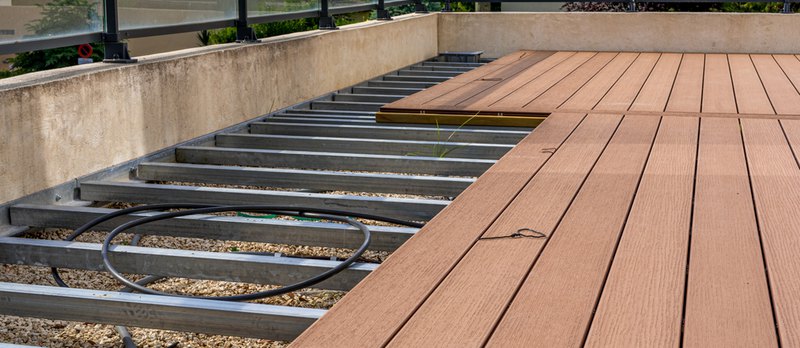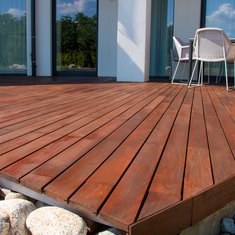When it comes to building an outdoor terrace, knowing, “What is the best wood for a deck?” is key to ensuring it lasts, looks great, and feels satisfying. Wood is a go-to choice for decks because of its natural beauty, versatility, and timeless appeal. Unlike synthetic materials, wood blends perfectly with the surrounding environment, creating a warm and inviting space for all your outdoor activities. At our lumber company, we offer a wide range of wood types so you can find the perfect fit for your design and budget. Let us help you choose the best wood for decks and create a beautiful, long-lasting deck you'll love.
Types of Wood for Decks

When picking the best wood for a deck, you’ve got a lot of great options, each with its perks. The wood you choose will affect how your deck looks, how long it lasts, and how much upkeep it needs. Whether you’re on a budget or ready to splurge on something premium, there's a type of wood that's perfect for you. Let’s dive into some of the most popular types of wood for decks.
- Cedar: Cedar is one of the best woods to use for a deck because it naturally resists rot, decay, and insect damage. Plus, it has a lovely reddish-brown color and a nice, pleasing smell.
- Redwood: Similar to cedar, redwood also resists moisture, insects, and decay. It has a rich, reddish hue and a straight grain that looks great.
- Pressure-Treated Wood: Usually made from pine, this wood for decks is treated to resist rot, decay, and termites. It's widely available and pretty affordable. But pressure-treated lumber can be unstable in dry climates.
- Tropical Hardwoods: Woods like Ipe’, Mangaris, Brazilian Redwood and Cumaru are super dense and durable. They handle the elements well and look stunning.
- Composite Wood: This isn't purely wood but a mix of wood fibers and plastic. It’s durable, low-maintenance, and comes in various colors and textures.
Each type has charm and benefits, so you can pick the best wood for outdoor use that fits your style and needs.
Benefits of Different Deck Wood Types
When it comes to building your deck, each deck wood type brings its own set of benefits to the table. Different woods offer unique advantages, from natural beauty and durability to ease of maintenance. Whether you want something low-maintenance, budget-friendly, or simply gorgeous, knowing the benefits of each type can help you decide what wood to use for your deck.
- Cedar: Lightweight and easy to work with, cedar doesn’t warp or split easily and ages gracefully to a silvery gray. It’s great for stability and looks.
- Redwood: Redwood’s natural oils protect it from moisture, making it less likely to warp or crack. Its stunning color and fine grain make it a favorite for a premium look.
- Pressure-Treated Wood: This wood is super durable and can handle harsh weather, so it will be the best wood to use outdoors. It’s a budget-friendly choice and can be stained or painted to fit any style. But pressure-treated lumber can be unstable in dry climates.
- Tropical Hardwoods:Woods like Ipe’, Mangaris, Brazilian Redwood and Cumaru are the best hardwood for decks. They are incredibly tough and resistant to scratches and dents. This wood is naturally resistant to insects and rot, making it a long-lasting option.
- Composite Wood: Composite decks are low-maintenance, resistant to fading, staining, and mold, and come in a variety of colors and textures. They’re a great, easy-care choice.
Maintenance Tips: What Wood is Best for Outdoor Use?
Besides the choice, “What wood is the best for outdoor use?” it is also important to maintain your wood deck, which is crucial for preserving its beauty, longevity, and safety. Regular care can prevent common issues such as rot, decay, and insect damage, ensuring that your deck remains a pleasant and functional outdoor space.
Keep your wood deck in good shape by giving it a regular sweep to clear away dirt and debris. For a deeper clean, use a mild soap and water mix or a wood cleaner and brightener with a soft brush. Check it out once a year for any damage like cracks or loose boards, and keep an eye out for pests like termites.
To prevent water damage, make sure your gutters are clear, and use planters with saucers to avoid puddles. Don't forget to shovel snow and ice in the winter! For UV protection on your wood deck, slap on some UV-blocking sealant or stain and toss on some outdoor rugs.
By following these maintenance tips, you can keep your wood deck looking great and working well for years. Regular care not only makes your deck look better but also keeps it safe and fun for outdoor activities.
What Type of Wood Is the Best For A Deck According To Prices?

The cost of decking wood can vary a lot depending on the type and quality. But what type of wood is best for a deck based on cost?
- Cedar: Costs between $4 to $6 per square foot. It’s a bit pricier than pressure-treated wood to build a deck, but its natural resistance and good looks make it worth it.
- Redwood: Around $6 to $8 per square foot. A little more expensive than Cedar, but you’re paying for premium quality and a stunning appearance.
- Pressure-Treated Wood: The cheapest option, costing $2 to $5 per square foot. It’s durable, easy to maintain, and gives you good value for your money. But pressure-treated lumber can be unstable in dry climates.
- Tropical Hardwoods: These are on the high end, costing $11 to $15 per square foot. It is the best wood for building a deck if you want something long-lasting and beautiful.
- Composite Wood: Priced between $7 and $15 per square foot. While it’s more expensive upfront, the low maintenance and long lifespan make it a good deal in the long run.
What Is the Best Wood for a Deck? Decide with Cedar Supply!
Choosing the best wood for an outdoor deck means balancing looks, durability, maintenance, and cost. Cedar and redwood are naturally beautiful and resistant to decay. Pressure-treated wood is a budget-friendly, durable option. Tropical hardwoods and composite materials might cost more, but they last a long time and need little upkeep. Think about your priorities and budget to pick the right wood for your needs, and enjoy a beautiful, long-lasting deck for years to come. At Cedar Supply, we provide high-quality outdoor wood decking and expert advice to help you keep your floor in top shape.
Not ready to tackle the job yourself and choose, “What is the best wood for a deck? No problem. Cedar Supply can provide you with a list of professional Fort Collins installation contractors throughout northern Colorado that will help you build your dream deck!
FAQ: What Wood Is Best for Outdoor Use?
1. What is the best wood to use for decks?
Cedar and redwood are excellent choices for their natural beauty and resistance to decay. Pressure-treated wood is a budget-friendly, durable option, while tropical hardwoods like ipe and mahogany offer exceptional longevity and stunning aesthetics.
2. What wood is most weather resistant?
Tropical hardwoods, such as Ipe’, Mangaris, Brazilian Redwood and Cumaru are among the most weather-resistant woods available. Their dense composition and natural oils make them highly resistant to moisture, insects, and decay.
3. What wood lasts the longest for decking?
Tropical hardwoods like Ipe’, Mangaris, Brazilian Redwood and Cumaru are known for their exceptional durability and can last up to 50 years or more with proper maintenance. Cedar and redwood are also long-lasting options, typically lasting 20-30 years.

